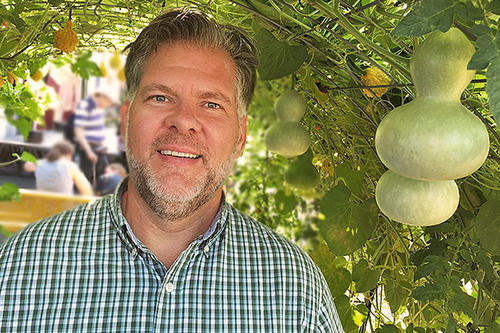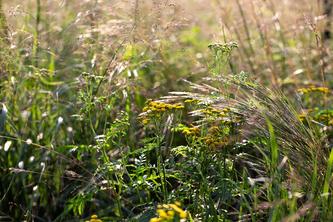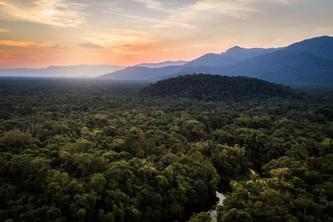
When Joel Karsten got his degree in horticultural science from the University of Minnesota in 1991, he had no idea his agricultural life would take him down the path of fine-tuning and promoting a novel way to grow food: straw bale gardening.
Straw bale gardening is, in Karsten’s words, simply a different kind of container gardening, with the “container” being a bale of straw held together by strings. The bale just needs to be “conditioned” with some type of fertilizer, be it nitrogen or even lawn fertilizer—a process that takes less than two weeks—and then it becomes a nutrient-rich plot of faux soil that can thrive in almost any climate.
(Karsten had a demonstration straw bale garden set up in front of the U of M Central Building at the Minnesota State Fair, and it was teeming with tomatoes, peppers, cucumbers, squash, basil, decorative gourds, flowers, and more.)
In Karsten’s case, being cash-poor and soil-poor at his new home in Roseville 29 years ago were the parents of his invention. Hailing from a farm near Worthington, Minnesota, he knew he wanted to grow a vegetable garden. “I was kind of in a pickle,” he says. “I didn’t have two nickels to rub together to do the soil modification that would need to be done or to build raised beds like a normal gardener would do.”
Remembering bales of straw back on the farm that would randomly sprout thistle and weeds, he did some experimenting. He treated rows of bales with different nutrients, from lawn fertilizer to plain nitrogen to chicken manure. As it turned out, each conditioning method bore fruit, so to speak.
For about 14 years Karsten honed his craft in relative obscurity, until KARE-11 featured him in an Extra story. “The next day, it just kind of exploded,” he says, and he started getting calls from garden clubs and people wanting more information on his method. He self-published a pamphlet, which turned into a booklet, and then he created a Facebook page in the early years of that platform.
That led to tens of thousands of followers worldwide, from Norway and Israel to Argentina and New Zealand. A longer guidebook gained a favorable review in the New York Times in 2013, and there are now more than 125 straw bale gardening groups online.
In the last three years, straw bale gardening has grown from a backyard endeavor to a movement he hopes can help alleviate hunger, since “growing food is about mitigating food insecurity.”
Karsten has been part of a project in Cambodia to mitigate the flood and drought season and provide nutrients beyond rice. His group piled up large plateaus of soil above flood level. They’ve assembled straw bales made of rice atop the plateaus and have been successful growing vegetables come drought or high water.
“If you figure out a way to fill empty stomachs without people having to invest money, you’d be surprised at how fast an idea spreads,” Karsten notes. “We went from zero people in Cambodia to 4,500 farmers now that are using this technique.”
The feedback he’s received—from serious but skeptical gardeners to seniors who appreciate the ease of the method (and the height of the bales)—keeps him going.
“It’s just overwhelming, he says. “It’s been the experience of my lifetime.”
- Categories:
- Agriculture and Environment





